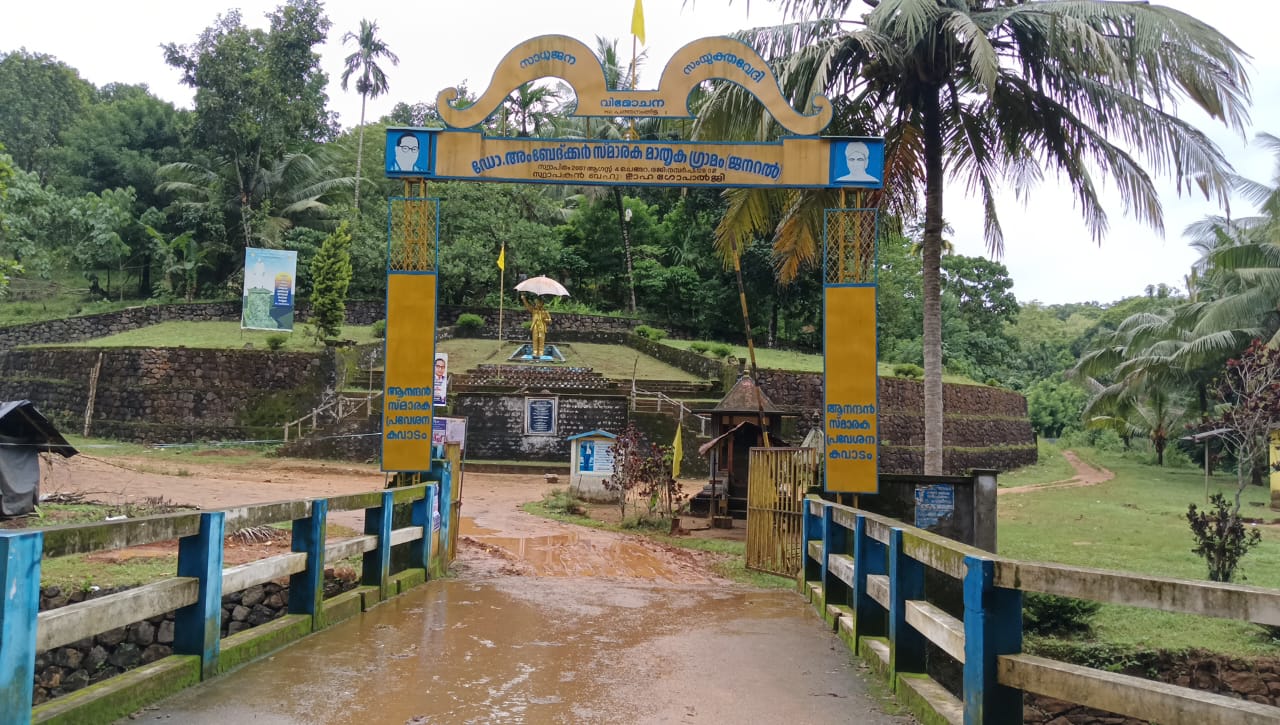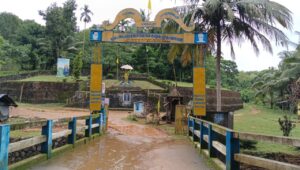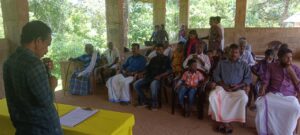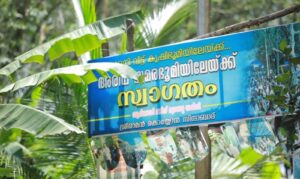The unresolved struggles of Chengara and Arippa stand as stark reminders that while governments showcase milestones of social justice and development, the lived realities of Dalit, Adivasi, and landless families tell another tale.
Published Oct 05, 2025 | 9:00 AM ⚊ Updated Oct 24, 2025 | 12:07 PM

Entrance to the Chengara Samarabhoomi.
Synopsis: While Kerala boasts of ambitious plans to become a land of zero landless and zero homeless, the landless Dalits and Adivasis fighting for their rights expose the reality. Over the years, successive governments have attempted negotiations but failed to deliver.
Kerala’s political narrative is one of unparalleled progress and social justice, boasting of ambitious plans to become a land of zero landless and zero homeless. However, that polished narrative cracks wide open on the ground.
For over a decade, two intense land struggles — Chengara (Pathanamthitta, 2007) and Arippa (Kollam, 2012) — have refused to die down.
These festering, unresolved battles also serve as a brutal mirror to the nine-year-old Left government, exposing the wide chasm between its lofty claims and the harsh reality faced by thousands still waiting for the promise of land reform.
As the protests grind on, they reveal an inconvenient truth: The government’s grand vision for an equitable Kerala remains tragically out of reach for those who need it most.

Entrance to Chengara Samarabhoomi
Can one imagine a child still studying by the dim glow of diesel lamps in an era when the state boasts unmatched development?
Or a residential area without electricity, piped water, proper roads, sanitation, healthcare or even basic schooling?
These are not rhetorical extremes, but the harsh reality facing families at Chengara’s Ambedkar Memorial Model Village, also known as Samarabhoomi, in Pathanamthitta.
What began on the night of 4 August 2007 — when roughly six hundred landless Dalit, Adivasi and other marginalised families under the banner of Sadhu Jana Vimochana Samyukta Vedi (SJVSV) and led by Laha Gopalan occupied nearly 145 hectares of the Harrison Malayalam Private Limited’s rubber estate, demanding five acres each — has become a long-running testament to unmet promises.
Naming the occupied land Samarabhoomi, the settlers made a home and a stand.
Talking to South First, SJVSV president KS Gopi said, “Denying or ensuring even the basic rights and amenities towards the downtrodden section of the society, like Dalits and Adivasi, is nothing new. No matter which faction helms the government.”
He further added, “There is this right to life, which is a fundamental human right, and it has also been guaranteed in our Constitution. But this has been denied to some 600 families for the past 18 years.”
Earlier, in 2009, the then-Left government, led by VS Achuthanandan, announced the Chengara Package, offering 831.03 acres across ten districts to 1,495 eligible families. While some accepted alternative land parcels, many rejected them as unsuitable because the plots were rocky and unviable.
In 2011, the movement re-launched and continued its struggle. The issue drew national attention — activists and public figures visited in solidarity — and legal orders urged eviction without bloodshed, even as occupants warned of mass protest.
The plight of children in Chengara’s Samarabhoomi has once again brought the settlement into focus, this time for the disturbing living conditions exposed by child rights and human rights commissions.
Acting on a complaint, Kerala State Commission for Child Rights member N Sunanda visited the colony and reported that children live in dire circumstances, deprived of nutritious food, clean clothes, proper shelter, and basic dignity.
The absence of a motorable road forces them to walk nearly three kilometres on broken terrain just to reach transport for school, making access to education a daily struggle. Sunanda noted that denying these children essentials like power, pathways, and water amounts to a violation of their fundamental right to life.

A meeting of inmates of Chengara Samarabhoomi
The Kerala State Human Rights Commission (SHRC) soon took suo motu cognisance, directing a district-level probe into deficiencies in road connectivity, electricity, drinking water, toilets, health care, and education.
Multiple departments, from the Public Works Department (PWD) to the Kerala State Electricity Board (KSEB) and the Education Department, have been instructed to conduct inspections and submit reports within six weeks.
The commission has also scheduled a review meeting with senior officials on 11 November.
Authorities now face pressure to deliver long-denied basic amenities to Chengara’s children.
Earlier, in 2022, the Kerala High Court had criticised the government for failing to honour its promise of providing land to landless Scheduled Caste and Scheduled Tribe families, stressing that it was a sovereign obligation tied to the principles of social justice.
Despite multiple assurances, progress remained slow.
By August 2025, Justice S Manu, reviewing reports and affidavits, found that implementation of the Chengara package had barely advanced.
While some land had been distributed, much of it was uninhabitable. Committees set up to coordinate the process did not produce any meaningful results.
Meanwhile, the court has ordered the Revenue Secretary to submit monthly progress reports from September, ensuring continuous judicial monitoring. Parallelly, Chief Minister Pinarayi Vijayan chaired a high-level meeting in September, instructing officials and ministers to accelerate the rehabilitation of 1,136 families.
The government has initiated measures such as ration card distribution, mobile ration shops, employment cards, solar lamps for students, medical camps, and improved anganwadi facilities.
The chief minister also stressed the urgent need for safe drinking water and healthcare access, underscoring the state’s renewed commitment to resolving the decade-old issue.
According to Gopi, the recent interventions have stirred some movement on the ground, with officials from almost every department — barring Revenue — finally meeting the families and holding discussions.
“Assurances were plenty, but we are not ready to gulp them down whole,” he remarked, voicing the community’s scepticism.
“We have heard promises before — like when land was allocated. Except for the parcel in Muvattupuzha, the others were unfit for living. So, we prefer to take these fresh promises with a pinch of salt. We know this is election season, and such words flow easily from those in power. What matters is not promises, but whether they translate into reality,” he added.
Almost 13 years after hundreds of Adivasi, Dalit, and landless families marched into the Arippa forest in Kollam district on the night of 31 December 2012, their demand for cultivable land remains unresolved.
The Arippa Bhoosamaram, launched with the slogan “We do not want three cents of land; we want land for cultivation,” continues to symbolise the unending battle of Kerala’s marginalised communities against state apathy and corporate interests.
When the lease of 90 acres of revenue forest land in Arippa, once held by business magnate Thangal Kunju Musaliar, expired in 2001, the state took over the land and declared it surplus.
Of this, 21.54 acres of land were allotted in 2009 to beneficiaries of the Chengara land struggle.
The remaining 68.46 acres were earmarked for institutional projects, including a Dr Ambedkar Model Residential School, a proposed international university campus, a biological park, and a dental college.
Disputing the allocation, around 500 families — many of them Chengara struggle veterans — entered the forest land in Arippa, Kulathupuzha, Kollam in December 2012, built shanties, and began a sit-in demanding cultivable land.
The protest was spearheaded by Sreeraman Koyyon, president of the Adivasi Dalit Munnetta Samiti (ADMS), who called it a continuation of Chengara land struggle.

A board welcoming people to the Arippa protest site.
Over the years, successive governments have attempted negotiations but failed to deliver. In February 2018, revenue officials surveyed to finalise beneficiaries.
A conciliation meeting chaired by the Revenue Minister in November 2024 reiterated the promise of land distribution, prioritising Scheduled Tribes, Scheduled Castes, and other marginalised sections.
However, protesters allege that the government has repeatedly backtracked.
They claim fresh surveys have been used to reduce the number of beneficiaries, and no steps have been taken to measure or demarcate the land.
“We were promised agricultural land, but nothing has moved forward,” said Koyyon then. “The government has failed to keep its word,” he alleged.
The protestors also alleged social ostracism, harassment by police and authorities and denial of even basic rights and amenities.
In June 2025, Revenue Minister K Rajan chaired a review meeting in Punalur, along with MLA PS Supal.
Officials reported that the government had already reclaimed 94 acres from the Musaliar family in 1997, of which 21.54 acres went into the Chengara package.
Early surveys in Arippa had counted 516 families—336 from Scheduled Castes, 54 from Scheduled Tribes, and 126 from other groups.
Today, the number stands at 297 families, spread across Kollam, Thiruvananthapuram, Kottayam, Pathanamthitta, Alappuzha, Kannur, Idukki and Palakkad districts.
The minister announced plans to provide pattayam (land titles) under the Landless Punalur Project, with a promise to complete procedures within a month.
But protesters remain sceptical, citing years of unmet assurances.
The struggle has also drawn political attention. Congress Working Committee member Ramesh Chennithala, inaugurating the 13th anniversary rally at Ambedkar Nagar in Arippa in September, described it as a fight for survival.
“The tribals and Dalits who are rightful owners of this land remain homeless. The government is unwilling to act because they are poor and marginalised,” he said, criticising the LDF government’s “double standards” on land issues.
Chennithala alleged that while lakhs of acres of land whose lease period has expired remain with corporate giants like Harrisons Malayalam, the government has consistently failed to reclaim them.
“Government lawyers are deliberately losing cases against big companies, allowing them to retain land illegally. But if tribals or Dalits occupy surplus land, cases are filed against them immediately. This discrimination exposes the government’s bias,” he said.
He reminded that during the Oommen Chandy government, a committee led by Rajamanickam IAS had been appointed to recover expired lease lands, but the initiative was abandoned when the LDF returned to power.
“With that, the attempt to seize land from bigwigs was derailed, while the poor continue to suffer,” Chennithala said.
He also pointed out that many Arippa families, despite being part of the Chengara rehabilitation package earlier, had been given barren or uninhabitable plots in Kasaragod, unsuitable for either housing or farming.
“This reflects the mindset of the authorities — that tribals and Dalits have no support, and that anything can be done with them,” he said.
Calling the government’s inaction “inhumane,” Chennithala condemned the police restrictions imposed on protest gatherings at Arippa.
“Even today, 1,700 families who are part of this land struggle are treated as if they don’t exist. This is not governance; this is negligence,” he declared, promising to take up the issue directly with the Revenue Minister.
The unresolved struggles of Chengara and Arippa stand as stark reminders that while governments showcase milestones of social justice and development, the lived realities of Dalit, Adivasi, and landless families tell another tale — one of promises made, promises broken, and lives still in limbo.
Whether the state can finally bridge this gap will determine if its vision of a “zero landless, zero homeless” Kerala remains rhetoric or becomes a reality.
(Edited by Muhammed Fazil.)
